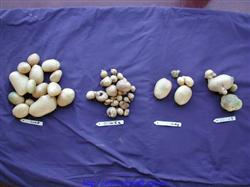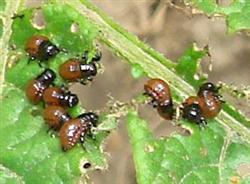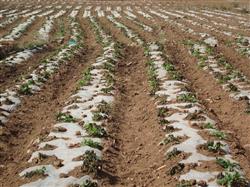Causes and Control measures of malformed Potato

Malformed potato is an important problem that some growers ignore while blindly increasing yield, that is, abnormal potato often appears in the process of tuber growth, especially in spring cultivation in the second season, because of high temperature and drought, the rate of deformed potato is high, which seriously affects the commerciality of potato and greatly reduces the planting benefit of potato. In this paper, the causes and control measures of deformed potato are summarized for reference in production. 1. The cause of abnormal potato is mainly caused by secondary growth. The main reason for secondary growth is sudden rainfall or watering after high temperature and drought, which makes the tubers that had stopped growing under suitable growth conditions, but at this time, the tuber epidermis has partially or completely aged, and the buds without aging resume growth and starch synthesis, thus forming a variety of deformities. 2. Prevention and control measures 1. The selection of excellent varieties of malformed potato often occurs on mid-mature or mid-late-maturing varieties, so when planting potatoes, especially on poor drainage or heavy soil, or there are no watering conditions in the local areas with high temperature and little rain during the growing period, varieties that are not easy to have secondary growth should be selected according to local cultivation conditions. 2. the application of organic fertilizer contains a large number of elements and trace elements needed for the growth and development of potatoes. the application of organic fertilizer can make the soil loose and fertile, improve the aeration condition of the soil, and improve the water and fertilizer retention capacity of the soil. to prevent the soil from being too dry and wet to cause tuber deformities, it also expands the tubers, making the tubers neat and smooth. In order to improve the soil conditions, more attention should be paid to the application of organic fertilizer to increase the yield, especially when planting potatoes on clayey soil. Organic fertilizer should generally be used as base fertilizer, and require deep application, ordinary fertility plots per 667 square meters apply 4000 to 5000 kg. 3. Excessive fertilization can easily lead to exuberant plant growth and even long growth. If the corresponding cultivation and management measures do not keep up in time, it will inhibit the expansion of tubers and lead to deformities. Potato needs potassium, which absorbs the most potassium, followed by nitrogen and phosphorus. Fertilizer can be applied in two ways: base fertilizer and topdressing, with organic fertilizer as the main fertilizer and nitrogen fertilizer as the main fertilizer in the early stage, in order to promote the rapid growth of aboveground stems and leaves, generally topdressing urea 10 kg 15 kg or ammonium bicarbonate 40 kg 50 kg per 667 square meters. topdressing twice during the whole growth period, the number and times of topdressing depend on soil fertility and plant growth, and excessive fertilization is strictly prohibited. In order to promote tuber growth during tuber forming period, some potassium fertilizer can be added appropriately, foliar spraying is adopted, and potassium dihydrogen phosphate with a concentration of 1 ‰ is generally used. 4. timely watering potato seedlings generally do not need watering, when the soil is too dry, it must be watered, but after watering, it is necessary to carry out mid-ploughing in time to break the consolidation and increase the soil temperature. After budding, potatoes should be watered frequently according to soil moisture to ensure that the soil is moist and the land is not dry, usually watered every 7 to 10 days. According to the soil condition, watering is generally stopped 5-7 days before harvest, which is beneficial to the safe storage of tubers after harvest. Avoiding drought during the growth period, especially watering after drought in the tuber expansion period, will result in the secondary growth of tubers to form deformed potatoes. 5. Strengthening the function of ploughing and cultivating soil is mainly to improve the ventilation of soil, increase the ability of soil moisture and fertilizer conservation, make potato skin smooth, potato shape neat, and reduce the proportion of abnormal potato. During the whole growth period, potato was ploughed for 2 to 3 times and soil was cultivated for 2 times according to the situation. The first intertillage was carried out 3-5 days before emergence, and the second intertillage was carried out after the seedlings emerged, and the last intertillage should be completed before the ridges of potatoes were closed. When the tip of the stolon began to expand in the budding stage, the first cultivation was carried out to prevent the stolon from escaping from the ground into new branches, and the potato entered the peak stage of expansion. In order to prevent the tuber from exposing to the ground, the soil was cultivated for the second time. The thickness of the soil was 4cm. A high ridge with a height of about 25 cm was formed, the roof was not flooded, the ridge was not hardened, and the soil permeability was good, which was beneficial to the expansion of the tuber.
- Prev

Identification and Control of Potato Beetle
Potato beetle, also known as potato leaf beetle, is a kind of quarantine pest in China. This insect originally lived on wild Solanaceae plants in the eastern foothills of the Rocky Mountains in the western United States. Because artificially bred potatoes can provide good nutrition for this beetle, coupled with the development of potato cultivation and transportation all over the world.
- Next

Difference between Frost injury and Disease of Potato
Freezing injury: from the plant growth appearance, after the plant is frozen, the leaves and heart leaves have no disease spots, and the leaves are dark green. When the sun shines, the leaves appear to be wilted and seem to be cooked leaves. After 1-2 days, the leaf margin curled inward until withered, but the new leaves growing from the heart leaves had no symptoms of wilting. Disease: the plant is affected by.
Related
- Where is it suitable to grow horseradish in China? it is expected to see the middle altitude horseradish in Alishan.
- How to prevent tomato virus disease reasonably? (Control methods included)
- Many people like to plant towel gourd on the balcony. What are the main points of this method and management?
- What crops can chili peppers be mixed with?
- Fertilization techniques and matters needing attention in Tomato
- What are the grafting techniques for peach seedlings in spring?
- Harm and control methods of root swelling disease of Chinese cabbage
- What are the pests of sweet potatoes? How to prevent and cure it?
- Symptoms, causes and Control methods of navel Rot in Tomato
- The cause of "Cucumber rotten bibcock" in Farmers' planting Cucumber and its Control Plan

